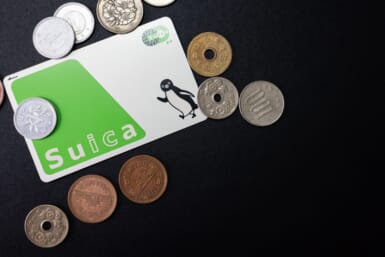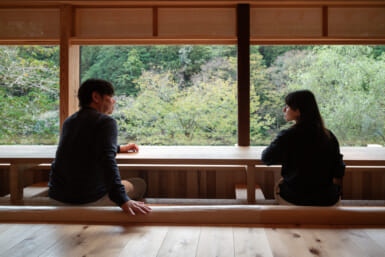I went down to Yokohama last weekend, to hear a friend of mine—Burritt Sabin, the editor of The East—talk about the town, and its origins and the Black Ships of the 1850s. Burritt worked in a lot of detail, some of it lurid, and all no doubt impeccably researched. He introduced many a new topic, using material that mostly fell outside the scope of his newly-published A Historical Guide to Yokohama, Sketches of the Twice-Risen Phoenix, in talking to a luncheon audience at the YC&AC.
Burritt, an American, who first came here as a naval officer in 1975 and settled down in Japan, teaching himself the language, has made himself into a world-class authority on Yokohama, and he talks like one. He brought with him, to show us all, a U.S. portrait of the famous Commodore Matthew Calbraith Perry—he who commanded the Black Ships and opened up Japan after 250 years of self-imposed isolation—and he showed us a Japanese caricature of the man.
When he pulled out this cartoon of Perry, by an unknown Japanese artist, and flourished this goblin-like face, it occurred to me not for the first time that, still, we must look very odd—we Westerners who live here—to the local inhabitants.
But put it the other way round, how do they look to us? And how closely do we observe them? Some years ago, a friend and I were browsing in Jimbocho, the secondhand book district, and we came across a mint condition copy of Perry’s narrative of his expedition. My friend, a rich man, bought the edition at once, more or less snatching it from beneath my nose. But by that time I had had a chance to case the material. Heavens, what a labor of love.
Here is a not widely known fact, Perry brought with him biologists, botanists and surveyors and others, trained to observe, and they compiled a staggeringly meticulous record of all they had seen, drawing it by hand.
I would give Perry and his men 99 out of 100, for their efforts as “journalists,” well, as skilled observers, who got everything down in their notebooks and left us with a record, second-to-none, of a Japan where what is now the city of Yokohama was nothing but a broad beach, the hinterland of which stank of piss—as Mr. Sabin mentioned the other day.
How could they have done so markedly good a job, with the tools at their disposal, I wondered. It was in their spirits, it was in their souls. They showed an immense respect for this country.
All of which makes me reflect on the efforts of others, down the years, to chronicle and record what transpires here. Moving forward to the 20th century, I would rate as the most magnificent effort in the field of Western journalism on Japan a superlative 1930s special issue on this country brought out by Fortune magazine.
I don’t have it in front of me, as I write, but I have seen it—I used to work for them here, and Fortune sent me a copy of the special issue from New York, which we then conveyed to Ambassador Mike Mansfield, at his request. The year of that edition would have been 1936.
Fortune, it may be said, marched in the footsteps of Perry and his men. They lacked time, they lacked patience. So I would score them only 60 out of 100 for their efforts. But they did attempt a broad-brush view of Japan—its constitution, its politics and its society on the verge of the catastrophe of Japan’s intrusion into Mainland China. This report was second to none in the century that just ended, I do believe.
Where, then, are we today? Mr. Sabin’s learned lecture made me reflect on that, as he so clearly himself marches in the footsteps of the first American naval people to surface here. How do our humble efforts rate in comparison with the giants of the past?
Looking at the daily and weekly stuff that flows from here, honestly, I think a true report would be that we rate about two out of 100, at maximum. Our reporting is puerile, second-hand and largely inaccurate, when it comes to Japan, and that applies to the “best” of our publications.
“What is going on, why are they so bitter, twisted and wrong?,” a British banker friend inquired of me the other day. “I don’t know,” I answered, and that was an honest answer. I don’t know why we fall down on the job. Can we not stand on the shoulders of the giants of the past, and thereby see further than they?
The short answer is no. Or, one might put it differently, only an occasional effort—such as Mr. Sabin’s historical guide to Yokohama—brings us within spitting distance of a noble standard that the Perry people established. But that is rare indeed.
So something is wrong. When I look at simple, basic stuff—such as how we report business news—I have to say our efforts are pathetic. The other day, for example, Toyota declared an absolutely whacking increase in profits. And how did our Western media respond? With a yawn. But, hang on a moment, is this the same company that is cutting a swath straight through the competition in Detroit, and is on the way to bringing ’em to their knees? Well, actually yes it is.
Or look at Walmart’s business deals with Jusco—has no one been to the Shinagawa Mall and seen first-hand the difference? Evidently, no. More? What about Goldman Sachs’ purchase of a whopping 100 golf courses in Japan? Also, in the opposite direction, we have a foreign company, Virgin Cinemas, selling its operations to Toho. Who is talking to the people behind deals such as these? No one.
If we cannot manage even such elementary reporting as this, how are we supposed to be able to address loftier themes along the lines of “whither Japan?” On that score, the stuff my colleagues have produced in recent years has been laughable. Or it would have been, had it not been treated as gospel in the West, thereby creating a general impression that Japan is about to sink beneath the waves.
Are we looking at difficult times; a huge shift in business styles? Yes. Look to the ghosts of Perry’s people, the editors of Fortune of yesteryear—predicting the future requires legwork and first-hand analysis.









